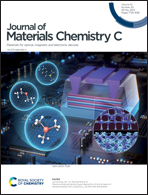A unique electronic state in a ferromagnetic semiconductor FeCl2 monolayer
Abstract
Two-dimensional (2D) van der Waals (vdW) magnetic materials could be an ideal platform for ultracompact spintronic applications. Among them, the FeCl2 monolayer in the triangular lattice is subject to a strong debate. Thus, we critically examine its spin-orbital state, electronic structure, and magnetic properties, using a set of delicate first-principles calculations, crystal field level analyses, and Monte Carlo simulations. Our work reveals that the FeCl2 monolayer is a ferromagnetic (FM) semiconductor in which the electron correlation of the narrow Fe 3d bands determines the band gap of about 1.2 eV. Note that only when the spin–orbit coupling (SOC) is properly handled, the unique  electronic ground state is achieved. Then, both the orbital and spin contributions (0.59 μB plus 3.56 μB) to the total magnetic moment well account for, for the first time, the experimental perpendicular moment of 4.3 μB per Fe. Moreover, we find that a compressive strain further stabilizes the
electronic ground state is achieved. Then, both the orbital and spin contributions (0.59 μB plus 3.56 μB) to the total magnetic moment well account for, for the first time, the experimental perpendicular moment of 4.3 μB per Fe. Moreover, we find that a compressive strain further stabilizes the  ground state, and that the enhanced magnetic anisotropy and exchange coupling would boost the Curie temperature (TC) from 25 K for the pristine FeCl2 monolayer to 69–102 K under 3–5% compressive strain. Therefore, FeCl2 monolayer is indeed an appealing 2D FM semiconductor.
ground state, and that the enhanced magnetic anisotropy and exchange coupling would boost the Curie temperature (TC) from 25 K for the pristine FeCl2 monolayer to 69–102 K under 3–5% compressive strain. Therefore, FeCl2 monolayer is indeed an appealing 2D FM semiconductor.



 Please wait while we load your content...
Please wait while we load your content...